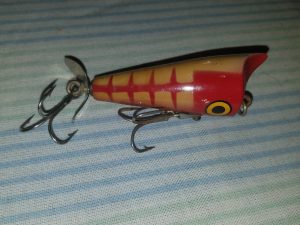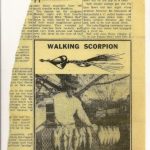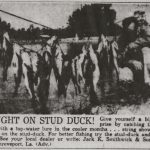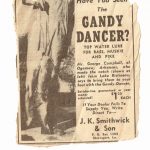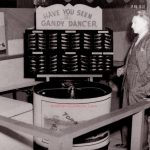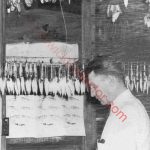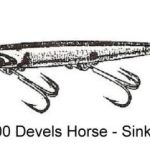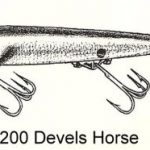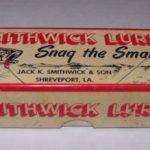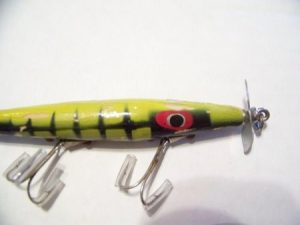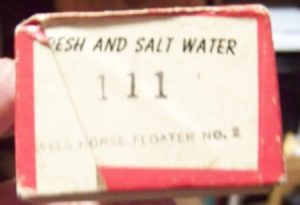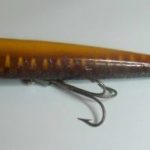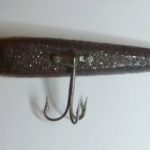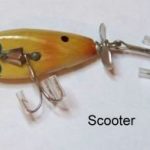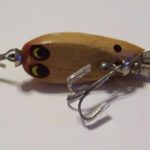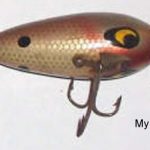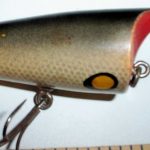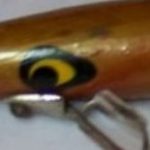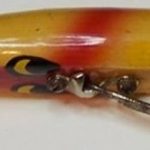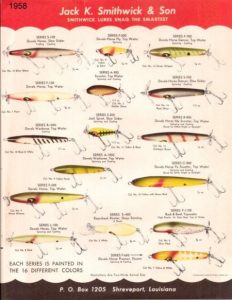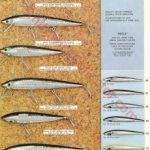We begin by reproducing this page from the 1980 Smithwick catalog about the origins of Smithwick Lures. Then we move into our reconstruction of the history of Smithwick Lures from 1947 – 1992 when the company was sold to PRADCO.
- Signed by Jack K. Smithwick
1947 – 1948 (estimated date range)
In the late 1940’s Jack Smithwick worked for Friden Calculator Co as a salesman. For years Jack had whittled wooden fishing lures. He began giving these creations out to his current and potential clients. He stamped the company name of them (Friden calculator Co.).
- By 1949 it was called the Gandy Dancer.
Based on customer feedback Jack decided to begin trying to sell fishing lures as a business. One of his early lures was this one. The name is partially obscured, but I think it says: Smithwick’s Wasp. By 1947 it was called the Jack Sprat.
- By 1947 it was called the Jack Sprat
- By 1947 it was called the Jack Sprat
By about 1947 he came out with the Top-N-Bottom lures under the Smithwick Lure & Son name. His first lures were the Top-N-Bottom and the Jack Sprat.
- T-N-B Lures
- 2″ Jack Sprat
1947 – 1948 (estimated date range)
Limited production/distribution
We know that Jack K. Smithwick started making lures in his garage in 1947.
- This is the letterhead he used for his new company:
His first series of lures were:
Top-N-Bottom – Small (aprox 2 3/8”)
Top-N-Bottom – Medium (aprox 3”)
Top-N-bottom -Large (aprox 3 3/8”)
Top-N-Bottom Jack Sprat (2”)
They were listed on the original paper insert he used in the Top-N-Bottom Box. Top-N-Bottom lures have been found in other sizes as well: 2” and 4”
- Top-N-Bottom Paper Insert
- 2 1/4″ Top-N-Bottom lure
1948
In 1948 Smithwick decided to expand his line of fishing lures. Remember that in the late 1940’s Smithwick was giving out lures that he made, stamped Friden Calculator Co. We had a picture of a lure stamped with the Friden name and was later in the Smithwick lineup named the Gandy Dancer. He decided he wanted to SELL the Stud Duck and he had to make a deal with the person who designed it.
In 1948 there was an article in the Shreveport Journal which stated… John Thomas who spends much of his spare time making fishing lures, has sold the rights to two of his designs on a royalty basis to Smithwick Co. They were the Stud Duck and the Jugger (haven’t heard of this one. Perhaps it is the Snapper).
Lures on the 1948 chart include: Stud Duck, Gandy Dancer, Snapper, Buck and Bawl, Hornet, Jack Sprat, Twister, Well Digger and the Wanderer.
- 1948 Apr 16 Shreveport journal
1949 –
The following lures were advertised in the newspaper in 1949:
Walking Scorpion, Stud Duck, Gandy Dancer, King Snipe.
- 1949 Ad for Walking Scorpion
- Have You Seen The Stud Duck?
- Caught on Stud Duck
- Have You Seen The Gandy Dancer?
- Gandy Dancer Drawing
All of the lures thus far were sold under the Top-N-Bottom brand and packaged in the Top-N-Bottom box shown here.
- The box was 4 ½” long, 2” wide and 1 ¼” deep.
Jack attended a State Fair in about 1950. We have a picture of his exhibit. The only lures at the fair were the: Gandy Dancer, Buck-N-Bawl, Stud Duck, Twister, Snapper, Hornet, Jack Sprat. Just these Top-N-Bottom era series of lures but not the original Top-N-Bottom lures, which I suspect were discontinued by this time.
- Have You Seen The Gandy Dancer?
1951 – 1952 (estimated date range)
Limited Production/distribution
They advertised the King Snipe in the newspaper in 1948 & 1951.
- For More Action – Try a “King Snipe”
- 400 King Snipe Drawing
We have a picture of Jack Smithwick, in his garage, putting King Snipe lures in Top-N-Bottom boxes.
- Jack In The Garage
By about 1951 or 1952 Jack developed two new lures which become an instant success. The first was the Devil Horse Sinker shown on the chart as Series 100, which later become the S-100. Second, the Devil Horse Floater shown on the chart as the Series 200 which later become known as the F-200.
- S-100 Devels Horse Sinker Drawing
- F-200 Devels Horse Drawing
This was a blessing and a problem. Neither of them will fit in the existing Top-N-Bottom box. He needed to make the box longer. I do not know how he packaged them until the change in the box was made. But instead of simply making the Top-N-Bottom box longer he changed both his letterhead and the boxes to reflect the new brand, Smithwick Lures. The original Top-N-Bottom box was 1 ¼” high and 4 ½” long. It was a light tan/green color. The new box was also 1 ¼” high but was 5 1/8 ” long. The new box was Red and White with a jumping bass on it.
- The box was 4 ½” long, 2” wide and 1 ¼” deep.
- It said: Smithwick Lures Snag the Smartest.
You will notice on the 1951 – 1952 chart that he dropped the original line of lures except the Gandy Dancer and the Stud Duck. The chart also carried the new brand, the same as the box: Jack K. Smithwick & Son; Smithwick Lures Snag The Smartest. I have seen a picture of a Stud Duck that was sold in the new 1 1/4′ Red and White box. The box was stamped: Stud Duck 1208 which was the color Shad. The 1951 – 1952 chart shows the new lineup.
1. Series 100 Devil Horse, Slow Sinker 2. Series 200 Devil Horse, Top Water 3. Series 300 Jack Sprat, Slow Sinker 4. Series 400 King Snipe, Top Water 5. Series 500 My Pet, Top Water 6. Series 600 Tootsie Bug (backwards), Sinker 7. Series 700 Tootsie Bug (forward), Sinker 8. Series 800 Walking Scorpion, Buck Tail 9. Series 900 Walking Scorpion, Rubber Skir 10. Series 1000 Smithwick Special 11. Series 1100 Gandy Dancer 12. Series 1200 Stud Duck.
We know from magazine articles that the Devils Warhorse was produced and sold during 1951 even though it does not hit the charts until 1958. So not all lures in production show up on the charts. This 1951 – 1952 chart was the introduction of the Devil Horse. Chart for lures sold in 1951 – 1952 (Devil)
The Jack Sprat shown on the 1951 chart is a different lure from the Top-N-Bottom Jack Sprat of 1949.
- The 1951 – 1952 Chart
1952 (estimated date) (Devil)
This chart seems to have quickly followed the former chart. The only difference is color number 12 changed from Silver Shiner to Chinkapin Bream. They also presented the lures in 2 columns instead of 3 columns.
It still shows the spelling: Devil Horse.
He used the correct spelling of Devil for a very short time. This quickly changed to the spelling DEVELS and he used this spelling until 1962. It is said that he was afraid that people would be hesitant to buy it if he spelled it Devil.
I believe this to be correct. Follow the charts from here forward. Watch the introduction of colors, lures, discontinued colors and lures, eyes, and hook hangers. They follow a progression. It would be totally inconsistant if you assumed these first Devil charts were from 1963 when the name changed to Devils. I understand the earlier thinking on this, they did not have all these charts available to gather the data to conclude otherwise.
- The 1952 Chart
He used the correct spelling of Devil for a very short time. This quickly changed to the spelling DEVELS and he used this spelling until 1962. It is said that he was afraid that people would be hesitant to buy it if he spelled it Devil.
I believe this to be correct. Follow the charts from here forward. Watch the introduction of colors, lures, discontinued colors and lures, eyes, and hook hangers. They follow a progression. It would be totally totally inconsistent if you assumed these first Devil charts were from 1963 when the name changed to Devils. I understand the earlier thinking on this, they did not have all these charts available to gather the data to conclude otherwise.
We know that we are probable missing some charts for 1953 to 1957.
This was an era of experimentation in lure design and colors. They produced many colors not on the standard chart.
You could go to the factory and order any color you wanted as long as you bought a dozen at a time.
Sales continued to grow and production expanded.
Smithwick currently had the Devel Horse Series 100 Sinker and the wider Devel Horse Series 200 Floater.
They then used the 3 3/4″ Sinker blank and made another Floater. I found a lure and box. The Spelling on the lure was now “Devels Horse” The box had the following printed on it: 111 Devels Horse Floater NO. 2. That was color number 11 – Yellow, Black Ribs. This lure would later be named the F-100 Devels Horse.
This lure/box shown was produced sometime between the 1952 chart and the following chart 1953-1957 est.
Here is another example. The lure below is simply stamped “Scooter”. It comes before the lure on the 1953-1957 chart named “PA Scooter”
1953 – 1957 ? (DEVELS) (estimated date range)
Limited Production/distribution
I believe that the new stick baits become instant super stars in the Smithwick lineup.
I believe that Jack Smithwick quickly discontinued the My Pet, Tootsie Bug, Stud Duck and Gandy Dancer and expanded the “stick family”. Notice in the chart below that they changed the way the identified the lures. They now begin to use, Series and an Alphabet letter.
1953-1957 estimated
By the time this chart was out they had dropped some lures from the chart and added others.
Added: F-100 Devels Horse, Series 600 Prancer, F-700 Devels Horse Dancer Floater, S-700 Devels Horse Dancer Sinker, A-900 Scooter, B-900 Devels Horse Ma Scooter, C-900 Devels Horse Pa Scooter, Series 300 Devels Horse Rooter (I believe it is a different lure than the (H) Well Digger) Not on the Chart: Series 500 My Pet, Series 600 & 700 Tootsie Bug, Series 1100 Gandy Dancer, Series 1200 Stud Duck, (H) Well Digger
1953-1957 Insert estimated
- Front Side
- Back Side
These are two more examples of very early lures.
The lure shown here is stamped… Scooter. One a Floater and one a diver.
The My Pet is a name from a previously discontinued lure and is the blank that later becomes the Buck N Bawl Jr.
1955 (estimated date range)
Some of the early lures used screw eyes to attach the hooks. Then they began using a heavy hanger for the hooks.
In about 1955 they stopped using the old heavy hook hangers and began using the lighter hook hanger on their lures.
1957 (estimated)
By 1957 they were beginning to ramp up production and really push their line of lures through the large wholesale houses. They had begun to use Huey & Phillips Co. in Dallas, J.S. Oshman Co. in Houston, Richards & Conover Hardware Co. in Kansas City, KA, Cullum & Boron in Dallas, Sutcliffe’s Catalog, and I assume many others.
It was about this time that they made one more change in the boxes. They changed from the 1 ¼” high box to one that was 1” high. This would allow them to stack 5 layers of boxes in the same space that they could only put 4 layers of boxes before. Their line of lures just did not require the 1 ¼” high boxes anymore.
We are not sure when sales and production caused them to move operations from the garage to a factory, but at some point they did end up with quite a large factory operation.
1958 Mass production/distribution
By 1958 sales were in full swing in the wholesale houses. They came out with their first lure I.D. chart in color.
Added: L-100 Devels Horse (2 hook on F-100 body), A-1000 Devels Warhorse, B-1000 Devels Warhorse, F-500 Devels Horse Fly, S-400 Razorback Rooter.
Not on the Chart: Series 500 Devels Horse Rooter, Walking Scorpion, Smithwick Special, Series 400 King Snipe.
IMPORTANT NOTE – The 1958 chart was a 1 page 1 sided chart. It was the first chart in COLOR. Color was very expensive to produce in those days. Some lures were left off due to space and not because they were discontinued. The King Snipe continued to show up on later charts into the 1980’s. The Walking Scorpion shows up on the 1961 chart.
You will notice the difference in the lineup now compared to the earliest charts. The lures are now all along the “stick bait” design.
- 1958 Color Chart
In 1960
Jack K. Smithwick convinced his son to join him fulltime in the business. The son’s name was Jack A. Smithwick. Jack A. Smithwick had attended LSU at Baton Rouge and become a Geologist working for Humble Oil Co.
1963
This year brought some significant changes in the lineup. They changed the name of the series of lures from… DEVELS…. to Devils. They finally realized that the public would buy a lure with the correct spelling of … Devil.
1963 continued
They brought out a series of 6 ½” Musky lures. They changed the name of the Snake Head to Devils Horse Rooter. The L-100 Devils Horse with 2 hooks was dropped. The two Warhorse lures that used the F-100 and F-200 body changed from 2 hooks to 3 hooks.
I believe that this change from 2 hooks to 3 hooks on the F-100 and F-200 body (the ones with the round belly and not the flat belly series) was for a strategic marketing reason.
Smithwick had begun to sell blanks and making lures for other manufacturers. Many of these other manufacturers used 2 hooks on the lures. This helped to differentiate them from the Smithwick line which had 3 hooks. It is said that Smithwick manufactured lures for upwards of 10 others companies.
- This lure is a Dalton Fish Stick.
- This lure is from Jenson Tackle Co. – Waco, TX
1965
We found this ad in the 1965 issue of the Sporting Goods Dealer magazine:
Smithwick used their Metallizer to make these lures for Bass Buster.
- Ad for Custom Lures
- Metallizer
1969
In 1969 Smithwick introduced the Rogue. This line of lures would be very important to Smithwick sales in the 1970’s, 1980’s and1990’s.
1972
In 1972 Smithwick bought out Championship Tackle. This included rubber worms, spinners, etc.
Later in the 1970’s they brought out a full line of fishing sinkers: Bass Casting, Pinch On, Egg, Worm, Split Shot, Rubber Grip, and Rubber Grip Split Shot.
They introduced crank baits. These included the Water Gater, Lobo, Bo-Jack and Balsa Jack.
1975
Then in 1975 disaster struck. The factory burned down. They lost most of the old stock lures, prototypes and paperwork. This is why it has been so hard to develop a good historical timeline on Smithwick Lures.
We had to piece it back together like a jig saw puzzle.They moved the manufacturing operations to Ben Bacon’s lure manufacturing facility while they re-built the Smithwick factory.
1985
Jack K. Smithwick passed away at the age of 81.
1992
Pradco bought Smithwick Lures and merged it into their other lines of business. The 1993 PRADCO catalog shows they also owned: Rebel, Heddon, Cotton Cordell, Bomber, Silver Thread, Creek Chub, Soft Classics, and Excalibur.
2006
Jack A. Smithwick dies at the age of 74.
2007
The estate of Jack A. Smithwick holds an estate sale. They sold the items from the closed down Smithwick factory. Some of the information and pictures for this history summary came from that sale.


